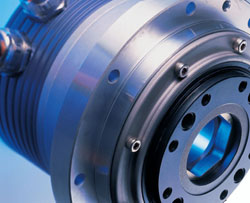
Posted to News on 21st Nov 2006, 20:19
Explaining the benefits of harmonic drives
Graham Mackrell, the UK sales director for Harmonic Drive, discusses the origins of harmonic drive technology and the benefits it offers today.

Harmonic Drive gears are noted for their ability to deliver precision motion control with very low or even zero backlash and vibration, providing high reduction ratios through concentric shafts in a lightweight yet robust assembly.
Invented in 1955 by the American C Walton Musser, the early development of the technology was under the auspices of the US NASA space agency. By the early 1970s, harmonic drives had been to the moon – powering the wheels of the Lunar Rover vehicle – and today they are still used in space on many satellites, including the Hubble Space Telescope and the International Space Station. Aerospace remains an important market for the drives because of their high precision allied with low weight, but they are also now widely used in many industry sectors for precision control of machinery such as robots, machine tools, printing presses, MRI scanners and aviation control surfaces.
Elegant concept
Ingeniously simple in design, all Harmonic Drives comprise just three concentrically mounted components: a wave generator, a flexible spline (Flexspline) and a circular spline. The wave generator is mounted on the motor's drive shaft (usually a servo motor), while the gear's output shaft is attached to the bottom of the Flexspline, which rotates within the rigid circular spline that is attached to the gear housing. However, it is what happens between the input and output shafts that is said to make the harmonic drive principle unique.
The wave generator is an assembly of a thin-raced ball bearing fitted onto a precision-machined elliptical 'plug', which serves as a high-efficiency torque converter. When pressed around the plug, the specially designed bearing conforms to the same elliptical shape, creating, in effect, an oval cam that bears against the inside of the Flexspline.
In turn, the Flexspline is a thin-walled flexible steel cylinder, or 'cup', with external gear teeth machined into its outer surface near the 'brim' of the cup where the Wave Generator is inserted. A flanged mounting ring for the output shaft is fixed at the other end of the Flexspline.
Difference of two
When the drive is assembled, the Flexspline's gear teeth mesh with those on the Circular Spline, which is basically a fixed steel ring with teeth machined into its inside diameter. The crucial point here, however, is that the Flexspline, being slightly smaller in diameter than the Circular Spline, is always machined so as to have two fewer teeth than the circular spline.
When the wave generator is rotated by the motor it imparts a continuously moving elliptical wave-like motion to the Flexspline. Because the Flexspline now adopts that elliptical shape, its teeth engage with the circular spline only at either ends of the major axis of the ellipse. On the minor axis the teeth are fully disengaged and so, as the ellipse rotates, the 'zone of engagement' progresses in a rolling fashion around the teeth of the circular spline. But because of the two-teeth difference between the Flexspline and the circular spline, each rotation of the wave generator effectively moves the Flexspline two teeth in the opposite direction.
So the high-speed input to the Wave Generator is reduced to a significantly lower output speed at a ratio given by dividing the number of teeth on the Flexspline by two (the teeth displacement per revolution).
Pitch errors neutralised
Apart from speed reduction, however, the Harmonic Drive design offers many other benefits. Unlike other types of gearing, such as planetary or spur gears, the teeth of a harmonic drive engage in such a way that approximately 30 per cent are meshed at all times, and exactly half of those engaging at any time are at 180 degrees to the other half (at either end of the ellipse axis), so pitch errors are neutralised. Positioning accuracy with drives such as those from Harmonic Drive – with single-stage reduction ratios of from 30:1 to 320:1 – can be better than one minute of arc with a repeatability within a few seconds of arc.
As part of the design, the teeth of the Flexspline are preloaded against those of the circular spline so that any wear in the teeth is compensated for and the drives operate with virtually zero backlash. Friction losses and wear are, in any event, negligible because of the way the teeth come into contact in almost a pure radial motion with almost no sliding velocity.
Advances on the basic harmonic drive design in recent years have seen the introduction of more and more compact units with higher torque capacities, and complete servo actuator systems consisting of Harmonic Drive gear, motor, servo control unit and integrated encoders in the one system.
Typical of such combined units, Harmonic Drive's FHA series also incorporates a hollow shaft design that allows the feed-through of cables, shafts or even laser beams as in a recent robotic installation for an automotive application – just one of the many advances that are helping expand the already wide-ranging field of applications for Harmonic Drive technology.
Want the latest machine building news straight to your inbox? Become a MachineBuilding member for free today >>
Unit 36, Wolseley Court
Staffordshire Technology Park
ST18 0GA
UNITED KINGDOM
+44 (0)1785 245190

















